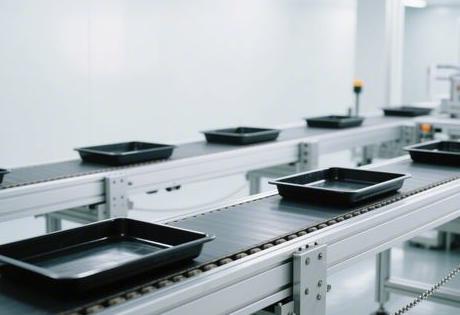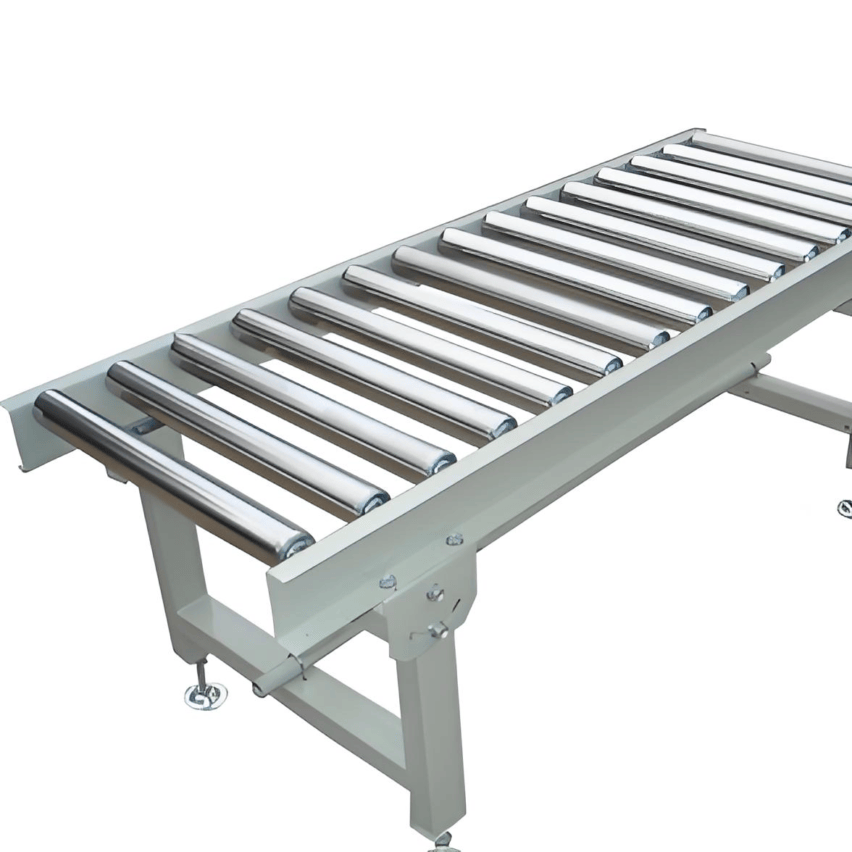In the midst of a wave of manufacturing automationDouble-deck speed chain conveyor line with its unique structure of "upper production and lower return".It has become a key technology to optimise space and improve efficiency. This article will deeply analyse its working principle, design logic and industry applications, and discuss the future direction of intelligent upgrading.

I. Structural Principle: How Double-Layer Circulation Achieves High-Efficiency Conveying
The double-deck speed chain consists of three core modules: the upper line, the lower return line and the transfer machine.. When the product completes the assembly process in the upper level of the speed chain, the unloaded tooling plate is automatically transferred to the lower level through the transfer machine, forming a closed loop system. Its core value is:
- Space Utilisation Improvement 50%The traditional single-layer line needs to reserve the return channel for the empty tooling plate, while the double-layer structure puts the return system in the lower layer, which directly saves the floor space of the production line.
- Beat Efficiency Optimisation 30%: Workpiece return is synchronised with production, eliminating waiting times for empty boards to be returned.
II. The growth rate mechanism: the delicate design of the physical structure
The "speed doubling" characteristic of the speed doubling chain is due to its special mechanical structure:
- Roller-roller diameter difference: Workpiece plate speed V = (1+D/d) × chain speed v (D is roller diameter, d is roller diameter). When D/d = 1.5, 2.5 times the speed increase is realised.
- Low friction engineering plasticsLight-duty chain adopts nylon rollers with a friction coefficient of only 0.08, which guarantees high-speed and stable operation.
Exclusive views: The actual growth rate is often lower than the theoretical value (approx. 151 TP3T loss), mainly originating from sliding friction due to deviations in the mounting of the guides. It is recommended to passLaser calibration of guide flatness, keeping the efficiency loss within 5%.

III. Key components: the industrial aesthetics of modular design
1.Body of the speed multiplier chain
- Triplex/2.5x chainEngineering plastic wheels (nylon) for light loads and carbon steel wheels for heavy loads.
- Dedicated aluminium profile guides: Embedded wear-resistant strips to reduce friction, precise control of ±0.5mm gap between the edge protection
2.Positioning control system
- Pneumatic stopper: SMC cylinders for millimetre-accurate stopping of work plates
- Photoelectric sensors: Real-time monitoring of workpiece flow to avoid build-ups
3.Transfer mechanism
Image Codegraph LR A[End of the upper line body] --> B{Top lift pan} B -->|Cylinder jacking C[Vertical lifting] C -->|Belt Transfer| D[Beginning of the lower line body]▲The load transfer process is controlled by PLC programming, and the repetitive positioning accuracy is up to ±0.2mm.
IV. Industry applications: solutions validated in multiple fields
1.Electrical and electronic industry
- Computerised assembly line.Workpiece speed up to 12m/minSupport monitor/host synchronous assembly
- Microwave oven production line: equipped with electrostatic protection work plate, to avoid damage to precision circuits.
2.automobile manufacturing
- Engine assembly line.Heavy duty carbon steel sprocket carries 500kg cylinder.2.5x speed operation
- Bodywork welding station: 90-second stopping time with a stopper robot
3.food and medicine
- Pharmaceutical packaging line: stainless steel chain in line with GMP hygiene standards
- Biscuit baking line: high-temperature resistant engineering plastic wheel adapted to 150℃ environment
V. Comparing single-tier systems: the real advantages revealed by the data
| norm | Double Speed Chain | Single layer speed multiplier chain |
|---|---|---|
| footprint (of a building, piece of equipment etc) | 100 square metres (baseline) | 180 m² (+80%) |
| maximum production capacity | 120 pieces/hour | 85 pieces/hour |
| Tooling board cycle time | 8 minutes. | 14 minutes. |
| Maintenance complexity | Medium (need to coordinate double layer synchronisation) | Low (single-plane operations and maintenance) |
Data from automotive parts production line measurements (2024)
VI. Technological Evolution: Three Major Directions for Intelligent Upgrading
- digital twin operations and maintenance (DTOM): Real-time mapping of physical wire body state to predict chain life
- AI dynamic speed control: Automatic optimisation of the multiplication ratio according to the blocking situation at the workstation
- modular reconfiguration:: Use of quick-release links for 1-hour line body reconfiguration
personal foresight: "reconfigurable double-layer doublespeed chains" by 2026, throughMagnetically controlled flexible tooling boardsBreak through fixed track limitations to support mixed line production.
Self-questioning: deeper understanding of the core issues
Q1: Why not just increase the chain speed instead of the multiplier design?
A: High speed operation of the chain can cause:

- Exponential increase in motor power (energy consumption ↑300%)
- Increased roller-guide impact (noise >85dB)
Doubling structure inWith controlled energy consumption and noiseAchieve efficient conveyance.
Q2: Which scenarios are not suitable for double-layer multiplier chains?
A: The following three types of scenarios suggest caution:
- Extra heavy materials (>1 tonne): lower supports need to be reinforced to increase costs
- Mini-workshops (<3 metres in height): significant compression of space on lower floors
- Frequent process changes: time-consuming transfer machine adjustments affect flexibility
As the manufacturing industry moves towards the intensification of the "inch of land", the double-layer speed multiplier chain tospace foldingtogether withtime compressionThe dual capability of the smart factory has continued to write the evolutionary chapter of efficient production. Its value has surpassed that of a mere conveying tool and become an indispensable part of an intelligent factory.Space-Time Architect.













